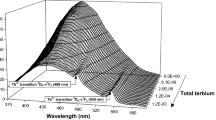Abstract.
Fluorescence techniques have been used to identify humic substances, (e.g. aquatic fulvic acids from different origins). Synchronous scans have proven adequate for distinguishing detail and differentiating samples. As well, fluorescence has often been used to probe humic interactions with metals and xenobiotic organics. In this study, the fluorescence of a well-characterized material, Laurentian fulvic acid (LFA) was compared with that of a simple hydroquinone/quinone (H2Q/Q) model system. Synchronous fluorescence (room T) and laser-excited fluorescence experiments at 10°K were carried out to characterize the fluorophore. The synchronous fluorescence behavior of LFA displayed similarities to that of an equilibrated, aerated, H2Q/Q system, but only at higher pH. (Higher pH favours a shift of the redox equilibrium towards quinone.) In contrast, the spectra of LFA suggest the role of “quinone” groups, even at lower pH. A significant feature of these spectra is a lowest energy band. At low temperature this band was more selectively excited at 470 nm, but vibrationally resolved line narrowed spectra were not observed. Fluorescence lifetimes were very short compared to the laser pulse width of ca. 10 ns. Under the low T condition the spectra of LFA and the model are essentially identical. We suggest that the principal luminophore in LFA is a quinone-hydroquinone type, perhaps a charge transfer complex consistent with the absence of the fluorescence line-narrowing phenomenon. The spectra imply a lowest energy component of LFA emission from a fluorophore very similar to that of the simplest H2Q/Q. The significant similarities of the model system to LFA are underscored by striking parallels in the radicals in the two systems seen in well-resolved electron paramagnetic resonance (EPR) spectra that could be obtained at pH = 6.
Similar content being viewed by others
Author information
Authors and Affiliations
Corresponding author
Additional information
Received: 8 January 2003; revised manuscript accepted: 28 September 2003
Rights and permissions
About this article
Cite this article
Ariese, F., van Assema, S., Gooijer, C. et al. Comparison of Laurentian Fulvic Acid luminescence with that of the hydroquinone/quinone model system: Evidence from low temperature fluorescence studies and EPR spectroscopy. Aquat. Sci. 66, 86–94 (2004). https://doi.org/10.1007/s00027-003-0647-8
Issue Date:
DOI: https://doi.org/10.1007/s00027-003-0647-8



